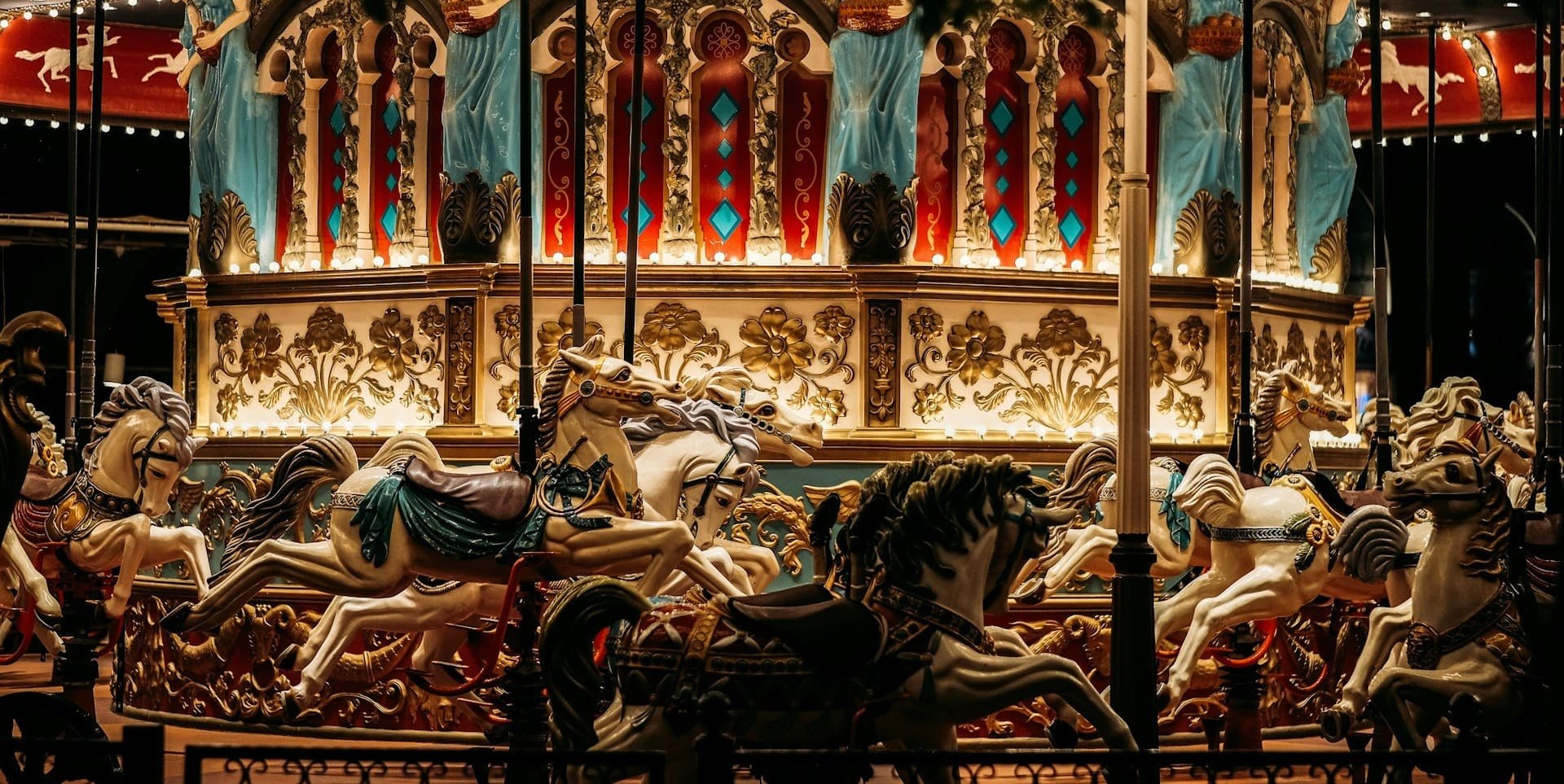Carousel
Mo | Tu | We | Th | Fr | Sa | Su |
Carousel – Václav Trojan | Opera
Language: Czech, with surtitles in Czech and English
Václav Trojan’s Carousel, an opera for children young and old, takes the audience on dreamy trips to the world of film and exotic lands, promising fantastic adventure.
Today Václav Trojan (1907–1983) is known primarily as a composer of outstanding scores for a number of 20th-century Czech films. The most noteworthy are the soundtracks to Jiří Trnka’s world-renowned animated movies Bayaya, Old Czech Legends, A Midsummer Night’s Dream and The Good Soldier Schweik; Bořivoj Zeman’s fairy tale Once Upon a Time There Was a King ..., featuring Jan Werich in the lead role; and Otakar Vávra’s August Sunday. Moreover, Trojan created the ballets Prince Bayaya and A Midsummer Night’s Dream, which were performed to acclaim at the National Theatre in Prague, and the stage poem Golden Gate, to folk motives. He wrote one opera, Kolotoč (Carousel), for children young and old, as the secondary title indicates. The owner of a merry-go-round invites children to climb aboard: “If you want to see Indians, a kangaroo and gorillas, take a seat on the carousel!” And indeed: in the scenes that follow children are taken on dreamy trips to an African rainforest, the Australian Outback, an Indian jungle, as well as to the world of American film. Characterised by bounteous instrumentation and exquisite melody, Trojan’s music co-creates a colourful fantasy story.
The National Theatre production will be conducted by Zbyněk Müller and directed by Magdalena Švecová. A key role in the performance will be played by the Czech Philharmonic Children’s Choir, whose founder, Jan Kühn, was among those who in the mid-1930s urged Trojan to write an opera for children. Following a series of setbacks, Carousel would only receive its world premiere decades later, in 1960 in Ostrava. The National Theatre will stage Trojan’s opera for the very first time.
Program and cast
Conductor: Zbyněk Müller
Carousel - Pavla Radostová; Eliška Minářová
Mr. Josef - Richard Samek; Tomáš Kořínek
Leader of the Siamese Hunters - Raman Hasymau; Vít Nosek
Moon - Miloš Horák; Ivo Hrachovec
Mother kangaroo - Sylva Čmugrová; Jana Sýkorová
Boy in aeroplane - Viktorie Krbcová
Boy in car - Anna Dostálová; Robin Tristan Sigaud
Boy on horseback - Klára Findeisová; Eliška Mistrová
A little girl on a duck - Angelika Broučková; Jana Hozmanová
Stage director: Magdalena Švecová
Sets and costumes: Zuzana Přidalová
Light design: Přemysl Janda
Animation: Tomáš Hrůza
Movement coach: Anton Eliaš
Chorus master: Lukáš Kozubík
Chorus master of the Prague Philharmonic Children´s Choir: Petr Louženský
Dramaturge: Beno Blachut
National Theatre Chorus
National Theatre Orchestra
National Theatre Opera Ballet
Czech Philharmonic Children’s Choir
Prague National Theatre
The National Theatre today
The historical building of the National Theatre, constructed in 1883, is generally considered the prime stage in the CzechRepublic. It is the flagship of the National Theatre institution, today amounting to five buildings and encompassing four companies. You can see there Opera, Drama and Ballet performances.
Idea of building a stately theatre for the Czech nation
The National Theatre is the embodiment of the will of the Czech nation for a national identity and independence. Collections of money among the broad mass of the people facilitated its construction and hence the ceremonial laying of its foundation stone on 16 May 1868 was tantamount a nationwide political manifestation.
The idea of building a stately edifice to serve as a theatre was first mooted in the autumn of 1844 at meetings of patriots in Prague. It began to materialise through a request for “the privilege of constructing, furnishing, maintaining and managing” an independent Czech theatre, which was submitted to the Provincial Committee of the Czech Assembly by František Palacký on 29 January 1845. The privilege was granted in April 1845. Yet it was not until six years later – in April 1851 – that the Society for the Establishment of a Czech National Theatre in Prague (founded in the meantime) made its first public appeal to start collections. A year later the proceeds of the first collections allowed for the purchase of land belonging to a former salt works with the area of less than 28 acres, which predetermined the magnificent location of the theatre on the bank of the river Vltava facing the panorama of Prague Castle, yet at the same time the cramped area and trapezoidal shape posed challenging problems for the building’s designers.
By car
To the centre (OldTown), approach on Masarykovo nábřeží (Masaryk embankment) in the direction from the Dancing House, at the crossroads in front of the National Theatre turn right to Divadelní street and then right again to Ostrovní street to the National Theatre car park. Parking costs 50 CZK/h.
By tram
By daytime trams Nos. 6, 9, 18 and 22 and night trams Nos. 53, 57, 58, 59 to the stop “Národní divadlo” – in front of the NT historical building; by daytime tram No. 17 to the stop “Národní divadlo”.
By metro
To the station “Můstek”, line B (yellow), and then by foot on Národní street; or to the station “Karlovo náměstí” and then two stops by tram No. 6, 18 or 22 to the stop “Národní divadlo”. To the station “Staroměstská”, line A (green), and then two stops by tram No. 17 to the stop “Národní divadlo”.

 EN
EN DE
DE IT
IT FR
FR ES
ES RU
RU JP
JP RO
RO
 Seating plan
Seating plan 